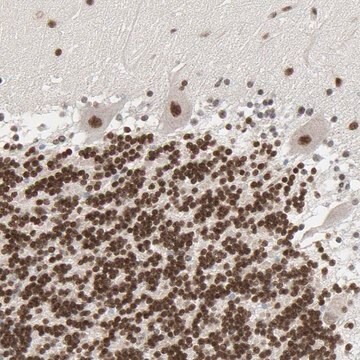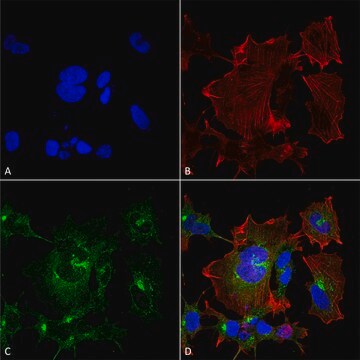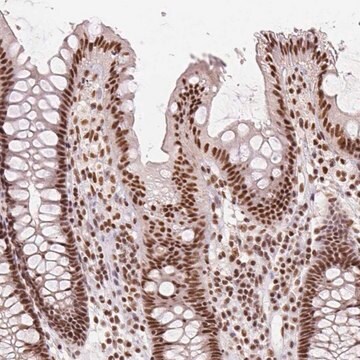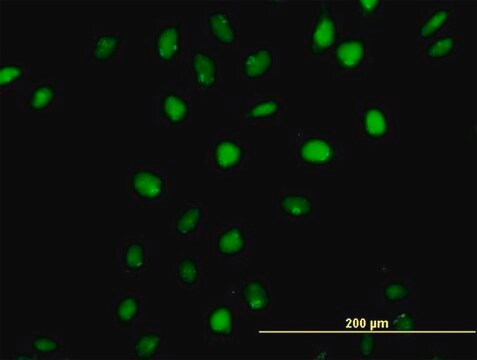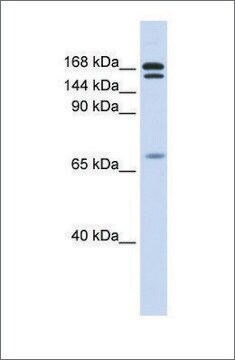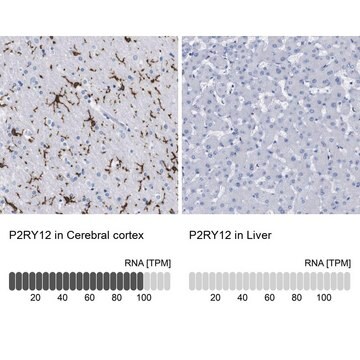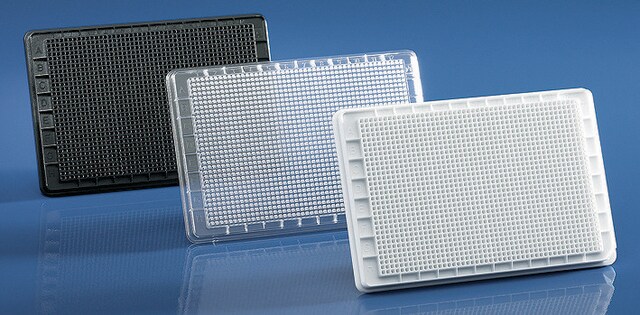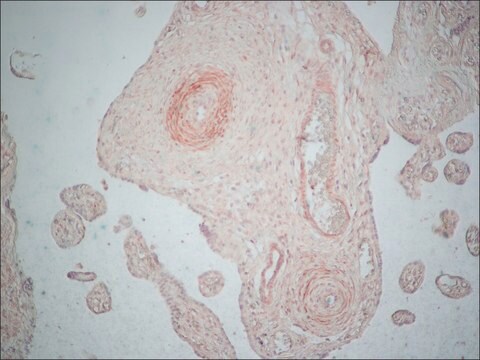HPA003317
Anti-CUX1 antibody produced in rabbit
Prestige Antibodies® Powered by Atlas Antibodies, affinity isolated antibody, buffered aqueous glycerol solution
别名:
Anti-CASP, Anti-CDP, Anti-CDP/Cut, Anti-CDP/Cux, Anti-CDP1, Anti-CUT, Anti-CUTL1, Anti-CUX, Anti-Clox, Anti-Cux/CDP, Anti-GOLIM6
登录查看公司和协议定价
所有图片(6)
About This Item
推荐产品
生物源
rabbit
品質等級
共軛
unconjugated
抗體表格
affinity isolated antibody
抗體產品種類
primary antibodies
無性繁殖
polyclonal
產品線
Prestige Antibodies® Powered by Atlas Antibodies
形狀
buffered aqueous glycerol solution
物種活性
human
技術
immunoblotting: 0.04-0.4 μg/mL
immunofluorescence: 0.25-2 μg/mL
immunohistochemistry: 1:50-1:200
免疫原序列
KSFQGEIDALSKRSKEAEAAFLNVYKRLIDVPDPVPALDLGQQLQLKVQRLHDIETENQKLRETLEEYNKEFAEVKNQEVTIKALKEKIREYEQTLKNQAETIALEKEQKLQNDFAEKERKLQETQMSTTSKLEEAEHKVQSLQTALE
UniProt登錄號
運輸包裝
wet ice
儲存溫度
−20°C
目標翻譯後修改
unmodified
基因資訊
human ... CUX1(1523)
免疫原
cut-like homeobox 1 recombinant protein epitope signature tag (PrEST)
應用
All Prestige Antibodies Powered by Atlas Antibodies are developed and validated by the Human Protein Atlas (HPA) project and as a result, are supported by the most extensive characterization in the industry.
The Human Protein Atlas project can be subdivided into three efforts: Human Tissue Atlas, Cancer Atlas, and Human Cell Atlas. The antibodies that have been generated in support of the Tissue and Cancer Atlas projects have been tested by immunohistochemistry against hundreds of normal and disease tissues and through the recent efforts of the Human Cell Atlas project, many have been characterized by immunofluorescence to map the human proteome not only at the tissue level but now at the subcellular level. These images and the collection of this vast data set can be viewed on the Human Protein Atlas (HPA) site by clicking on the Image Gallery link. We also provide Prestige Antibodies® protocols and other useful information.
The Human Protein Atlas project can be subdivided into three efforts: Human Tissue Atlas, Cancer Atlas, and Human Cell Atlas. The antibodies that have been generated in support of the Tissue and Cancer Atlas projects have been tested by immunohistochemistry against hundreds of normal and disease tissues and through the recent efforts of the Human Cell Atlas project, many have been characterized by immunofluorescence to map the human proteome not only at the tissue level but now at the subcellular level. These images and the collection of this vast data set can be viewed on the Human Protein Atlas (HPA) site by clicking on the Image Gallery link. We also provide Prestige Antibodies® protocols and other useful information.
生化/生理作用
CUX1 (cut-like homeobox 1) gene encodes a transcription factor belonging to the homeodomain family of DNA binding proteins. It functions as a transcriptional repressor and as an activator regulating cell differentiation and cell cycle progression. It modulates the invasion in various cancers and mediates resistance to apoptosis. It is involved in tumor cell survival in pancreatic cancer. It is involved in the control of food intake in both rodents and humans by regulating the expression of the FTO (Fat Mass and Obesity Associated) and RPGRIP1L (Retinitis Pigmentosa GTPase Regulator-interacting Protein-1-like) genes. It also coordinates leptin receptor signaling. Cux1 and Cux2 are involved in the regulation of dendrite branching, spine development, and synapse formation in layer II-III neurons of the cerebral cortex.
特點和優勢
Prestige Antibodies® are highly characterized and extensively validated antibodies with the added benefit of all available characterization data for each target being accessible via the Human Protein Atlas portal linked just below the product name at the top of this page. The uniqueness and low cross-reactivity of the Prestige Antibodies® to other proteins are due to a thorough selection of antigen regions, affinity purification, and stringent selection. Prestige antigen controls are available for every corresponding Prestige Antibody and can be found in the linkage section.
Every Prestige Antibody is tested in the following ways:
Every Prestige Antibody is tested in the following ways:
- IHC tissue array of 44 normal human tissues and 20 of the most common cancer type tissues.
- Protein array of 364 human recombinant protein fragments.
聯結
Corresponding Antigen APREST84785
外觀
Solution in phosphate buffered saline, pH 7.2, containing 40% glycerol and 0.02% sodium azide.
法律資訊
Prestige Antibodies is a registered trademark of Merck KGaA, Darmstadt, Germany
免責聲明
Unless otherwise stated in our catalog or other company documentation accompanying the product(s), our products are intended for research use only and are not to be used for any other purpose, which includes but is not limited to, unauthorized commercial uses, in vitro diagnostic uses, ex vivo or in vivo therapeutic uses or any type of consumption or application to humans or animals.
未找到合适的产品?
试试我们的产品选型工具.
儲存類別代碼
10 - Combustible liquids
水污染物質分類(WGK)
WGK 1
Marta Nieto et al.
The Journal of comparative neurology, 479(2), 168-180 (2004-09-29)
Little is known about how neurons in the different layers of the mammalian cerebral cortex are specified at the molecular level. Expression of two homologues of the Drosophila homeobox Cut gene, Cux-1 and Cux-2, is strikingly specific to the pyramidal
Stefanie Ripka et al.
Neoplasia (New York, N.Y.), 12(8), 659-667 (2010-08-07)
Previously, we identified the transcription factor CUX1 as an important modulator of invasion and resistance to apoptosis. Expression profiles suggested that CUX1 regulates a complex transcriptional program mediating tumor progression. We aimed to identify functionally relevant targets of CUX1 by
George Stratigopoulos et al.
The Journal of biological chemistry, 286(3), 2155-2170 (2010-11-03)
The first intron of FTO contains common single nucleotide polymorphisms associated with body weight and adiposity in humans. In an effort to identify the molecular basis for this association, we discovered that FTO and RPGRIP1L (a ciliary gene located in
Beatriz Cubelos et al.
Neuron, 66(4), 523-535 (2010-06-01)
Dendrite branching and spine formation determines the function of morphologically distinct and specialized neuronal subclasses. However, little is known about the programs instructing specific branching patterns in vertebrate neurons and whether such programs influence dendritic spines and synapses. Using knockout
S Ripka et al.
Gut, 59(8), 1101-1110 (2010-05-06)
The transcription factor CUX1 is known as a regulator of cell differentiation and cell cycle progression. Previously, CUX1 was identified as a modulator of invasiveness in various cancers. Based on expression profiles suggesting a role for CUX1 in mediating chemoresistance
我们的科学家团队拥有各种研究领域经验,包括生命科学、材料科学、化学合成、色谱、分析及许多其他领域.
联系技术服务部门
